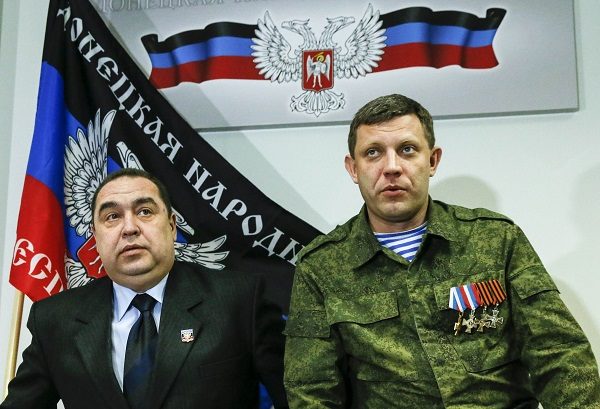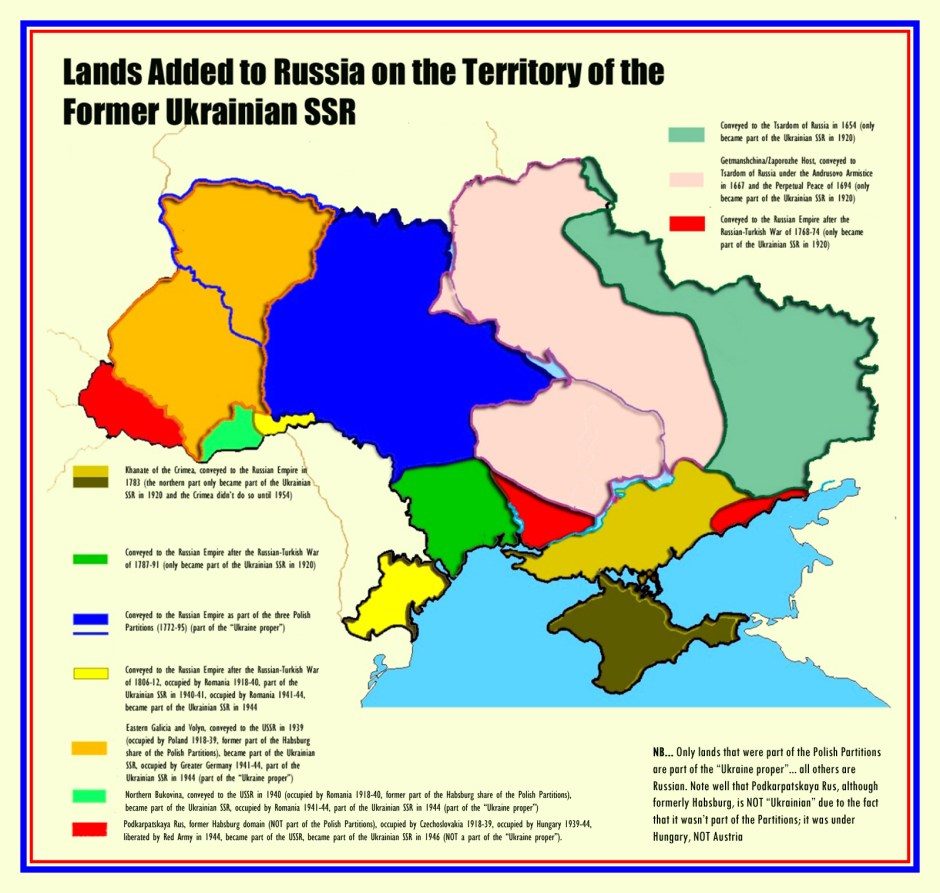In 1667, the Treaty of Andrusovo affirmed Russian sovereignty over historic Russian lands that had been part of the Polish-Lithuanian Commonwealth since the 14th century. These areas were de-facto Russian ever since the Treaty of Pereyaslav, signed in 1654 as an alliance between local Cossacks and the government in Moscow.
The restoration of Russian lands was affirmed in the 1686 Treaty of Perpetual Peace.
These regions became known as Malorossiya (Little Russian) and formed the triumvirate of the Three Russias under a single sovereign (Great Russia, Little Russia and White Russia). The lands of Malorossiya on the left-bank of the river Dnieper were later incorporated into further territorial gains from Poland-Lithuania on the right-bank of the river Dnieper in 1793.
In the 1764, former Ottoman regions around the Black Sea including the cities of Odessa and Donetsk formed Novorossiya or New Russia. The former Ottoman Khanate of Crimea formally linked up with this region in 1783.
The current borders of Ukraine were manufactured haphazardly under Bolshevik rule which effectively slammed together the historic regions of Novorossiya and Malorossiya with western regions bordering former Polish lands that had been subsumed by Austro-Hungarian rule in the late-modern period. Areas that were part of the Second Polish Republic between the world wars, including Galicia and the Czech and Hungarian regions of Carpathian Ruthenia, were incorporated into The Ukrainian Soviet Socialist Republic after 1945.
This odd mix of historic regions with different identities is the primary reasons that a conflict in the modern borders of Ukraine were simply a matter of "when" rather than "if".
This reality has been acknowledged by Alexander Zakharchenko, the leader of the Donetsk People's Republic who today announced the intent of Donetsk to lead a restoration of Malorossiya as part of a drive to reincorporate historic Russian territories into a close relationship with The Russian Federation.
Zakharchenko stated,
"We propose to establish the state of Malorossiya. Malorossiya is an independent young state. A transition period of up to 3 years.Donetsk People's Republic Income and Charges Minister Alexander Timofeev added the following,
...The state 'Ukraine' showed itself as a failed state and demonstrated the inability to provide its inhabitants with a peaceful and prosperous present and future.
We should be supported by the residents of the regions. This solution is possible provided that the international community supports the idea".
"We, the representatives of former Ukraine, declare the establishment of a new state, Malorossiya, which is a successor state to Ukraine. We agree that the new state's name will be Malorossiya because the very name of Ukraine has discredited itself. The city of Donetsk becomes Malorossiya's capital".He further stated that Malorossiya would develop a constitution based on discussions throughout the regions including in the new/revived area and would ultimately require approval via a democratic referendum.
Timofeev continued,
"Malorossiya is a multinational state with Russian and Malorossiyan being its official languages, and regional languages retaining their rights and statuses...When discussing the model of Belarus in respect of its relations with Moscow, Timofeev is alluding to the Union-State between Belarus and Russia which was created in 1996. This has allowed for open borders and common economic and military interests between Minsk and Moscow.
...The policy aimed at joining the Union State of Russia and Belarus while preserving independence and sovereignty. The keeping of a visa-free regime in agreement with the European Union. De-oligarchisation, un-cluding (sic) on a legal basis".
Zakharchenko affirmed that the new state might need to live under emergency conditions for three years due to aggression from remnants of the regime currently ruling in Kiev.
In spite of these difficulties Zakharchenko also struck an optimistic tone, encouraging people to dream big. Hestated,
"All of us here are going to talk about the future. We propose a plan for the reintegration of the country through the law and the Constitution. We must build a new country in which the concepts of conscience and honour are not forgotten. We offer the citizens of Ukraine a peaceful way out of the difficult situation, without war. This is our last offer not only to the Ukrainians, but also to all countries that supported the civil war in Donbass. I am convinced that we will do everything possible and impossible".Representatives at the meeting where the announcement was made were drawn from historic Malorossiya and Novorossiya regions including Kharkov, Dnepropetrovsk, Zaporozhye, Kherson, Nikolayev, Odessa, Sumy, Poltava, Chernigov, Kirovograd.
The leader of the regime in Kiev, Petro Poroshenko responded to Zakharchenko's statement saying that Kiev would reconquer both Donbass and the Russian territory of the Crimean peninsula. Both of these statements speak to just how out of touch Poroshenko is with the realities on the ground.
Although the organisational phases of creating Malorossiya will be difficult due to the position of the Kiev regime and almost certainly the European Union also, the idea underlines something The Duran discussed in November of 2016,
" If the (Kiev) regime fell due to a combination of internal incompetence and international isolation, chances are that a more moderate government could be formed. Ideally such a new government would be one that recognises the democratic right to self-determination exercised by the Donbass Republics, one less hell-bent on extreme corruption and hopefully one that would hold regional referenda on autonomy and/or independence".Historic regions of different cultural, linguistic and sovereign backgrounds cannot be slammed together into an artificial state for an eternity. History shows that such states are typically dissolved or radically reformed after a certain period of uncomfortable pseudo-coexistence.
The impending collapse of the regime in Kiev and the longer term re-defining of the borders of the state now called Ukraine will have to be addressed sooner or later. The proposals which came out of Donetsk today are as good a beginning on the road to much needed change as any.






Reader Comments